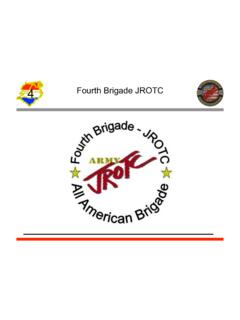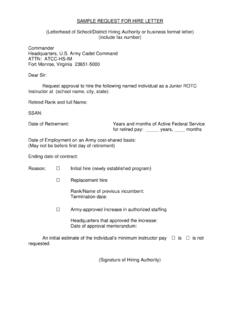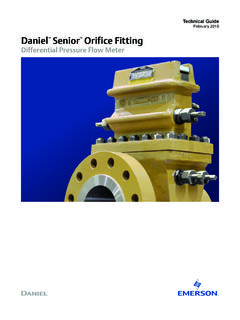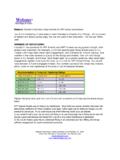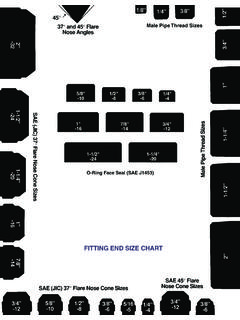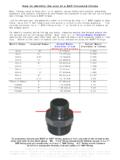Transcription of BASIC FITTING GUIDE FOR - 4th Bde JROTC
1 BASIC FITTING GUIDE FOR ARMY SERVICE UNIFORMS (ASU) MEN/WOMEN Program Manager Soldier Clothing and Individual Equipment June 2010 Table of Contents SECTION 1: Men Army Service Uniforms APPENDIX A: Men Size Prediction Charts APPENDIX B: NSNs for Men s Items SECTION 2: Women Army Service Uniforms APPENDIX C: Women Size Prediction Charts APPENDIX D: NSNs for Women s Items APPENDIX E: Suggested Sources MEN S UNIFORM ITEMS SECTION 1 FITTING OF MEN S UNIFORMS The Men s Army Service Uniform (ASU) is composed of an Army Blue 450 Coat and Army Blue 451 Trousers, an Army White 521 Long or Short Sleeve Shirt, necktie and the Black Beret.
2 A Coat, All-Weather, Black Shade 385, may be worn over the uniform. 1. Design: a. Coat. The coat is a four-button, single-breasted coat with peak lapels, front and underarm darts, two-piece back with vent, two top-pleated patch pockets with flaps and two lower inside hanging pockets with flaps. The shoulder loops for the coat shall be buttoned down and have rounded edges at edge nearest the collar and have 1/8 inch wide gold cord edge braid attached. The inside of the coat shall be 3/8 lined with yoke back, fully lined sleeves, and one inside breast pocket.
3 The coats shall have gold sleeve ornamentation attached to the bottom of the sleeves, 3 inches from bottom of hemmed sleeve. It is designed to fit slightly at the waist to conform to the individual s figure. b. Trouser. The trousers are a dress type with a sewn-on waistband with hook and eye closure, a French fly tab with slide fastener, straight on seam side pockets, double cord hip pockets and cut back darts. The left hip pocket has a buttonhole tab and button. The inside of the waistband has a rubberized non-slip tape. The leg front and back creases are treated with a permanent silicone adhesive bead. The trousers come in two classes, the Class 1 without ornamental braid is worn by enlisted personnel (E-1 through E-4 (Specialist) and the Class 2, with a 1-1/2 inch wide ornamental braid attached on side seams, is worn by officers and enlisted personnel (E4 (Corporal) through E-9).)
4 They are designed to fit smoothly, but not tightly, around hips, seat, and waist, with a slight fullness for comfort. The rise is automatically built into the trousers and varies with different lengths. c. Shirt (Short or Long Sleeve). The shirt shall be a dress style with a standup collar, collarstand and yoke. The collar shall contain collar stays. The shirt shall have two plain chest pockets with button through flaps. It shall also have a pen pocket inside the left breast pocket, approximately 1-1/4 inches wide, hemmed at the top and open at the bottom. The shirt shall have tapered shoulder loops and cuffs (Type I). Each shirt shall have permanent creases; three creases on the back and one on each front of shirt positioned in accordance with the marks on the pattern.
5 The creases shall have a continuous appearance on the front through the shirt, front of each pocket and pocket flap. The shirt is available in both long and short sleeves. The long sleeve shirt has two button interlined cuffs and is designed to be worn strictly with a tie. There is one extra button on bottom front of shirt. d. Necktie. The necktie is a four-in-hand type. e. Beret. The beret is a one piece knitted wool shell bound with leather and a drawcord through the binding. The beret has a flash sewn onto the badge stay. The beret is available lined or unlined. f. All Weather Coat. (1) All Weather Coat. The all weather coat is a six-button, double-breasted model with a belt.
6 The coat has a convertible collar (button at neck), right front gun flap, shoulder loops, adjustable sleeve straps and welt pockets with two inside hanging pockets. The back has a yoke and center vent. The coat is fully lined. 1 (2) Liner. The removable liner has bound edges, 1/2 raglan sleeves, 2 pass through pocket slits and center back vent, button loops at the bottom of each sleeve and zipper around the edge for attaching the liner to the coat. 2. Materials: a. Coat. to oz/linear yd., 55/45% polyester wool serge, Army Blue 450. b. Trouser. to oz/linear yd., 55/45% polyester wool serge, Army Blue 451. c. Shirt (Short or Long Sleeve).
7 + oz/sq yd., 65/35% polyester/cotton herringbone, durable press and stain resistant, Army White 521. d. Necktie. oz/sq yd., 75/25% polyester/wool tropical, Army Black 385. e. Beret. oz/sq yd., 100% wool, Army Black 1593. f. All Weather Coat. (1) Coat. to oz/sq yd., 65/35% polyester/cotton poplin, plain weave, water repellent treated, Army Black 385. (2) Liner. oz/sq yd., inch thick 65/35% polyolefin/polyester batting between two layers of + oz. sq yd. taffeta. The sleeves for the all weather coat shall be made from a oz/sq yd. multifilament acetate faced, combed cotton backed satin weave material. Both materials shall match the shade of the BASIC material.
8 3. Sizing System: The coats, trousers and shirts are available in both classic and athletic sizes. a. Coats. The coat sizes are related to the individual's chest, waist and height measurements. The coats are available in sizes 30-52 with lengths of X-Short (XS), Short (S), Regular (R), Long (L), and X-Long (XL). Refer to size Prediction Table (Table I) in Appendix A for available sizes. b. Trousers. The trouser sizes are related to the individual s waist measurement and height and are available in one inch increments. The trousers are available in sizes 30-52 with lengths of Short, Regular, Long, and X-Long. All trousers are labeled with waist size first, immediately followed by the inseam length.
9 Refer to size Prediction Table (Table II) in Appendix A for available sizes. c. Shirts (Short or Long Sleeve). The short sleeve shirts are available in 1/2 inch neck size increments from 13-1/2 through 18-1/2 inches with one sleeve length for all sizes. The long sleeve shirt is available in sleeve lengths of 29, 30/31, 32/33, 34/35, 36/37 and 38/39, with neck sizes in 1/2 inch increments from 13-1/2 through 20. Refer to size Prediction Table (Table III) in Appendix A for available sizes. d. Necktie. The necktie is one size fits all. e. Beret. The beret is provided with 1/8 inch size increments from size 6-3/8 through 8-1/4. Refer to Size Prediction Table (Table IV) in Appendix A for available sizes.
10 F. All Weather Coat. The all weather coat is available in two-inch size increments from size 30 through 52 and lengths X-Short (XS), Short (S), Regular (R), Long (L), and X-Long (XL). Refer to Size Prediction Table (Table V) in Appendix A for available sizes. 4. General FITTING Procedures. a. Coat. (1) Subgarments. Subgarments required for the FITTING of the coat are cotton underwear, dress shirt, polyester/wool trousers, socks, low quarter shoes, belt and buckle. (2) Measurements. The chest, waist and height measurements are needed for selection of the proper size and model try-on garment. 2 (3) Selection of Try-On Garment. Using the individual s chest, waist and height measurements, refer to Table I in Appendix A for size prediction of initial try-on size.

